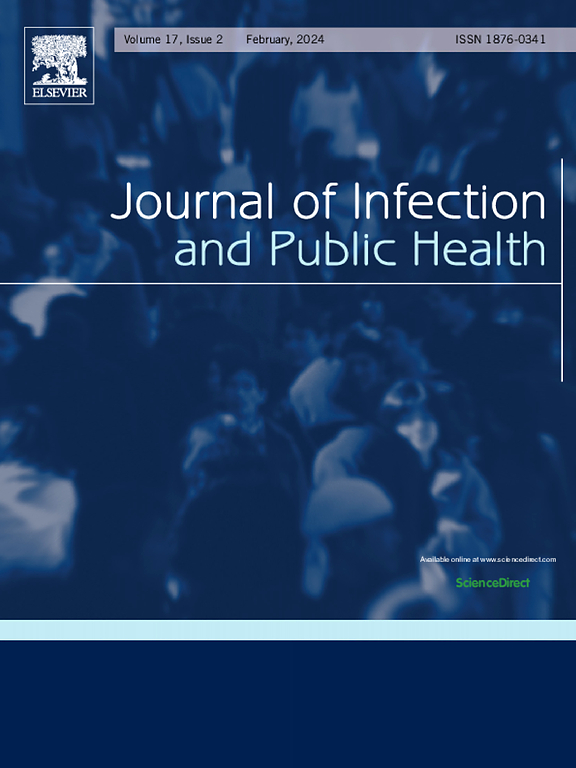Clinical features and antibiotic resistance in pediatric pneumococcal meningitis in Southern Vietnam, 2012–2023: A multicenter retrospective study
IF 4.7
3区 医学
Q1 INFECTIOUS DISEASES
引用次数: 0
Abstract
Background
Streptococcus pneumoniae is a major cause of morbidity and mortality in children. This study investigates the clinical features, cerebrospinal fluid (CSF) findings, serotype distribution, and antibiotic resistance patterns in Vietnamese children aged 1–59 months with pneumococcal meningitis (PM).
Methods
This retrospective study (2012–2023) was conducted at two tertiary pediatric hospitals in Ho Chi Minh City. CSF samples from probable bacterial meningitis (PBM) cases were analyzed using biochemistry, culture, and real-time polymerase chain reaction (rt-PCR). Serotyping and antibiotic-resistance genes were identified using quadriplex rt-PCR.
Results
Among 2922 PBM cases, 155 (5.3 %) were confirmed as PM. Of these, 58.7 % occurred in children under one year and 62.6 % during the rainy season. Fever (98.1 %) and vomiting (67.7 %) were the most common symptoms. Infants under 12 months frequently exhibited nonspecific signs like convulsions (48.4 %) and bulging fontanels (34.1 %), while older children displayed classic symptoms such as neck stiffness (32.4 %) and behavioral changes (26.5 %). CSF analysis revealed turbid appearance, WBC ≥ 100 cells/mm³ (85.2 %), and protein ≥ 1 g/L (60.0 %) (p < 0.05). Severe outcomes were noted in 17.4 % of PM cases, with a 3.2 % fatality rate. The 13-valent pneumococcal conjugate vaccine (PCV13) serotypes caused 81.3 % of confirmed cases, predominantly serotypes 6 A/B (34.8 %) and 19 F (20.0 %). Among 137 isolates tested, high prevalence rates were observed for the pbp2b (68.6 %), mef(A)/erm(B) (93.4 %), and tetM (92.0 %) resistance genes. Additionally, 61.3 % of isolates showed multiple resistance genes, particularly in serotypes 6 A/B, 23 F, 9 V, and 13. Antibiotic resistance in non-PCV13 serotypes increased over time.
Conclusions
PM in Vietnamese children presents age-specific clinical presentations and is predominantly caused by highly resistant PCV13 serotypes. The rising resistance in non-PCV13 serotypes poses a formidable challenge in managing pneumococcal infections. These findings emphasize the urgent need for PCV introduction in the national immunization program and ongoing resistance surveillance.
2012-2023年越南南部儿童肺炎球菌脑膜炎的临床特征和抗生素耐药性:一项多中心回顾性研究
背景肺炎链球菌是儿童发病和死亡的主要原因。本研究调查越南1-59月龄肺炎球菌性脑膜炎(PM)患儿的临床特征、脑脊液(CSF)检查结果、血清型分布和抗生素耐药模式。方法回顾性研究(2012-2023)在胡志明市的两所三级儿科医院进行。对疑似细菌性脑膜炎(PBM)病例的脑脊液样本进行生化、培养和实时聚合酶链反应(rt-PCR)分析。采用四联rt-PCR技术鉴定血清分型和耐药基因。结果2922例PBM中,155例(5.3 %)确诊为PM。其中,58.7% %发生在一岁以下的儿童中,62.6% %发生在雨季。发热(98.1% %)和呕吐(67.7% %)是最常见的症状。12个月以下的婴儿经常表现出非特异性症状,如抽搐(48.4% %)和囟门鼓胀(34.1% %),而年龄较大的儿童则表现出典型症状,如颈部僵硬(32.4% %)和行为改变(26.5% %)。脑脊液分析显示外观浑浊,WBC≥ 100 cells/mm³ (85.2% %),蛋白≥ 1 g/L(60.0 %)(p <; 0.05)。17.4% %的PM病例出现严重后果,死亡率为3.2% %。13价肺炎球菌结合疫苗(PCV13)血清型占确诊病例的81.3 %,主要是6 A/B(34.8 %)和19 F(20.0 %)血清型。在137株分离株中,pbp2b(68.6% %)、mef(A)/erm(B)(93.4 %)和tetM(92.0 %)耐药基因阳性率较高。此外,61.3 %的分离株显示多重耐药基因,特别是血清型6 A/B、23 F、9 V和13。非pcv13血清型的抗生素耐药性随着时间的推移而增加。结论越南儿童spm具有特定年龄的临床表现,主要由高耐药PCV13血清型引起。非pcv13血清型不断上升的耐药性对管理肺炎球菌感染构成了巨大挑战。这些发现强调迫切需要在国家免疫规划中引入PCV并进行耐药性监测。
本文章由计算机程序翻译,如有差异,请以英文原文为准。
求助全文
约1分钟内获得全文
求助全文
来源期刊

Journal of Infection and Public Health
PUBLIC, ENVIRONMENTAL & OCCUPATIONAL HEALTH -INFECTIOUS DISEASES
CiteScore
13.10
自引率
1.50%
发文量
203
审稿时长
96 days
期刊介绍:
The Journal of Infection and Public Health, first official journal of the Saudi Arabian Ministry of National Guard Health Affairs, King Saud Bin Abdulaziz University for Health Sciences and the Saudi Association for Public Health, aims to be the foremost scientific, peer-reviewed journal encompassing infection prevention and control, microbiology, infectious diseases, public health and the application of healthcare epidemiology to the evaluation of health outcomes. The point of view of the journal is that infection and public health are closely intertwined and that advances in one area will have positive consequences on the other.
The journal will be useful to all health professionals who are partners in the management of patients with communicable diseases, keeping them up to date. The journal is proud to have an international and diverse editorial board that will assist and facilitate the publication of articles that reflect a global view on infection control and public health, as well as emphasizing our focus on supporting the needs of public health practitioners.
It is our aim to improve healthcare by reducing risk of infection and related adverse outcomes by critical review, selection, and dissemination of new and relevant information in the field of infection control, public health and infectious diseases in all healthcare settings and the community.
 求助内容:
求助内容: 应助结果提醒方式:
应助结果提醒方式:


